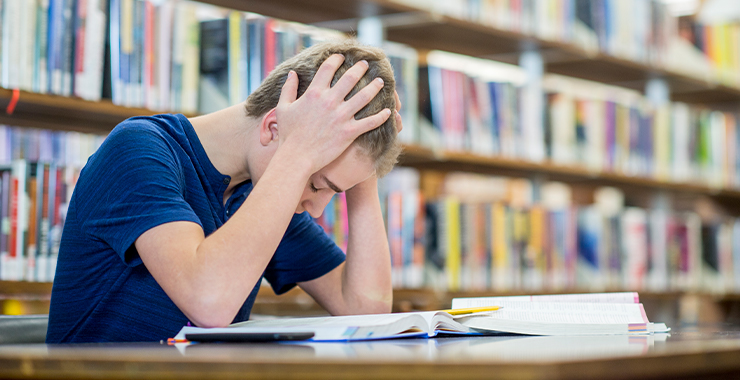Ethics Across the Professions Publication Info Baby Bib
How to assist children and teens manage their stress
Stress is a normal part of life at every historic period. Here are healthy ways for children and teens to cope.

In the curt term, stress tin can push a child to practice for her pianoforte recital or inspire a teen to study when he'd rather be out with friends. But chronic stress is different.
Left unchecked, long-term stress tin can contribute to a long list of concrete and mental health problems. Prolonged stress tin cause high blood pressure, weaken the allowed organization and contribute to diseases such equally obesity and heart disease. Information technology can also lead to mental health problems such as anxiety and depression—disorders that are becoming more common in youth. In a 2018 study, researchers analyzed data from the National Survey of Mental Health and found that rates of feet and depression had increased in kids ages 6 to 17, from 5.4% in 2003 to 8.4% in 2011-12.
Stress in immature people doesn't always look similar stress in adults. Simply like adults, children and teens can find healthy ways to cope. Together, immature people and their parents can acquire to spot the signs of backlog stress and, with the right tools, manage information technology.
Sources of stress in young children
For young children, tension at dwelling house is a mutual source of stress. Children may be troubled by family discord or divorce, for case. Large life changes, such as a new stepparent or new habitation, tin can also exist hard on a child. That's true fifty-fifty when the changes are happy ones, such as the arrival of a new sibling.
School is another frequent source of business organization for kids. Young children might be stressed well-nigh making friends, dealing with bullies or getting forth with their teachers. They might also be anxious about tests and grades.
Sources of stress in adolescents and teens
As children get older, their sources of stress expand. Teens are more likely than young children to be stressed by events or situations outside the abode.
But equally information technology is for younger kids, school remains a meridian stressor. A 2013 survey by APA found that stress was extremely common among teenagers: 83% of the teens surveyed said schoolhouse was a meaning or somewhat pregnant source of stress. Simply academics aren't the only matter worrying today's youth. A 2018 APA survey found that young people ages 15 to 21 — Generation Z — report significant stress around social problems in the news (PDF, 3.7MB), including gun violence and school shootings, rising suicide rates, climate change, handling of immigrants and sexual harassment.
Peers can help buffer stress, but can also be a source of information technology. Social relationships are especially important in adolescence. Many teens worry well-nigh plumbing fixtures in, their beginning romantic relationships and peer force per unit area around substance use and sexual activity.
Recognize the signs of stress
Signs of stress in youth tin show upward in a number of means:
- Irritability and anger: Children don't always accept the words to describe how they are feeling and sometimes tension bubbling over into a bad mood. Stressed-out kids and teens might be more than short-tempered or argumentative than normal.
- Changes in behavior: A young child who used to be a great listener is of a sudden acting out. A one time-active teen now doesn't desire to leave the firm. Sudden changes tin can be a sign that stress levels are high.
- Trouble sleeping: A kid or teen might complain of feeling tired all the time, sleep more than usual or have problem falling asleep at night.
- Neglecting responsibilities: If an adolescent of a sudden drops the brawl on homework, forgets obligations or starts procrastinating more than usual, stress might be a factor.
- Eating changes: Eating besides much or likewise footling can both be reactions to stress.
- Getting ill more frequently: Stress often shows up equally concrete symptoms. Children who experience stress often report headaches or stomachaches, and might make frequent trips to the schoolhouse nurse'south office.
Stress management for kids and teens
Facing stressors is a fact of life, for children and adults. These strategies can help keep stress in check:
- Slumber well. Slumber is essential for physical and emotional well-being. Experts recommend ix to 12 hours of sleep a night for 6- to 12-twelvemonth olds. Teens need 8 to ten hours a nighttime. Sleep needs to be a priority to keep stress in check. To protect shut-heart, limit screen use at night and avoid keeping digital devices in the bedroom.
- Exercise. Physical action is an essential stress reliever for people of all ages. The U.S. Section of Health and Human Services recommends at least sixty minutes a day of activity for children ages 6 to 17.
- Talk it out. Talking about stressful situations with a trusted adult can help kids and teens put things in perspective and find solutions.
- Make fourth dimension for fun — and quiet. Just like adults, kids and teens demand time to do what brings them joy, whether that'due south unstructured time to play with building bricks or uninterrupted hours to practice music or art. Also, while some children thrive bouncing from i activity to the adjacent, others need more down fourth dimension. Find a healthy balance between favorite activities and free fourth dimension.
- Get outside. Spending time in nature is an effective way to save stress and improve overall well-beingness. Researchers have plant that people who live in areas with more light-green space take less depression, anxiety and stress.
- Write about it. Research has found that expressing oneself in writing can help reduce mental distress and improve well-beingness. Some research has establish, for instance, that writing well-nigh positive feelings—such as the things you're grateful for or proud of — tin ease symptoms of anxiety and depression.
- Learn mindfulness. In a study of a five-week mindfulness grooming program for 13- to 18-twelvemonth-olds, researchers found that teens who learned mindfulness experienced significantly less mental distress than teens who did not.
How parents can assistance
Parents and other caregivers have an important part to play, by adopting their own healthy habits and helping children and teens find stress-managing strategies. Some ways parents tin can take activity:
- Model healthy coping. Caregivers tin can talk with children about how they've thought nigh and dealt with their own stressful situations.
- Let kids be problem-solvers. It's natural to want to fix your child's problems. But when parents swoop in to solve every piddling glitch, their children don't have a take chances to learn good for you coping skills. Let your children endeavour to solve their low-stakes problems on their ain, and they'll proceeds confidence that they tin deal with stressors and setbacks.
- Promote media literacy. Today'south kids spend a lot of time online, where they tin can run into questionable content, cyberbullying or the peer pressures of social media. Parents tin can aid by teaching their children to be savvy digital consumers, and by limiting screen fourth dimension.
- Gainsay negative thinking. "I'thousand terrible at math." "I hate my pilus." "I'll never make the team. Why try out?" Children and teens can easily fall into the trap of negative thinking. When children utilise negative self-talk, though, don't just disagree. Inquire them to really recollect near whether what they say is true, or remind them of times they worked hard and improved. Learning to frame things positively will help them develop resilience to stress.
References
National Institute of Mental Health: 5 Things You Should Know Most Stress
Epidemiology and Bear on of Health Care Provider-Diagnosed Anxiety and Low Among U.Southward. Children, Bitsko, R. H., et. al., Periodical of Developmental & Behavioral Pediatrics, 2018
APA: Stress in America 2013 Highlights
APA: Stress in America, Generation Z (2018) (PDF, iii.7MB)
American Academy of Pediatrics: American Academy of Pediatrics Supports Childhood Sleep Guidelines
Exposure to Neighborhood Green Space and Mental Wellness: Evidence from the Survey of the Health of Wisconsin Beyer, G.G., et. al., International Journal of Environmental Research and Public Health, 2014.
Online Positive Impact Journaling in the Improvement of Mental Distress and Well-Being in General Medical Patients With Elevated Anxiety Symptoms: A Preliminary Randomized Controlled Trial Smyth, J.Thou., et. al., JMIR Mental Health, 2018
Taming the Adolescent Mind: A Randomised Controlled Trial Examining Clinical Efficacy of an Adolescent Mindfulness‐Based
Lodge of Clinical Kid & Boyish Psychology: Effective Kid Therapy
Recommended Reading


Children's Book Daughter $14.99


Members may qualify for lower pricing
Source: https://www.apa.org/topics/child-development/stress
0 Response to "Ethics Across the Professions Publication Info Baby Bib"
Postar um comentário